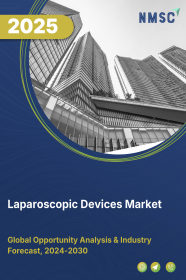
Laparoscopic Devices Market by Product Type (Laparoscopes, Energy Devices, Insufflators, Trocars and Access Devices, Hand Instruments, Closure Devices, Suction & Irrigation Systems, and Robot-assisted Laparoscopic Devices), by Application (General Surgery, Gynecological Surgery, Colorectal Surgery, Bariatric Surgery, Colorectal Surgery, Bariatric Surgery, Urological Surgery, and Pediatric Surgery), by End User (Hospitals, and others)- Global Opportunity Analysis and Industry Forecast, 2021-2030
Market Definition
The Laparoscopic Devices Market size was valued at USD 12.88 billion in 2020 and is predicted to reach USD 63.41 billion by 2030 with a CAGR of 17.3% from 2021-2030. Laparoscopy is a surgical procedure performed by medical professionals to examine the organs inside the abdomen. This is a low-risk, minimally invasive surgery that requires only a small incision. The laparoscope consists of a long but thin tube with high-intensity light and a high-resolution camera in the front. As it passes through the abdomen, the camera transmits the image to the monitor.
The necessary equipment to perform laparoscopy is laparoscopes, irrigation system, inflation set, trocar, sample collection bag, wound protector, internal closure device, gastric band, manual assist device, and power system, among others. Laparoscopy is generally used for operations involving the pancreas, stomach, intestines, and bile ducts.
Laparoscopy is also used to diagnose and treat endometriosis, ectopic pregnancy, pelvic inflammatory disease (PID), cysts, and fibroids. The use of laparoscopic devices during surgery ensures minimal bleeding and helps maintain haemostasis. Compared to the common open surgery, in laparoscopic surgery patients have many advantages such as reduced pain due to smaller incisions, less bleeding, and needs shorter recovery time.
Market Dynamics and Trends
The introduction of laparoscopic technology has completely changed the world of surgery through the gradual evolution from open surgical procedures to minimally invasive surgery. The increasing adoption of minimally invasive surgery (MIS) is mainly driving the growth of the market. Also, the new advancement in surgical technology and the increasing number of gynaecological and urological operations are few other factors driving the growth of the laparoscopic devices market.
Moreover, these devices are widely preferred by physicians as well as surgeons due to the high level of precision provided by laparoscopic devices. Furthermore, rise in metabolic & bariatric surgeries executed globally in order to lessen weight, accelerates the laparoscopic devices market growth. According to the data published by the American Society for Metabolic & Bariatric Surgery (ASMBS), in 2019, the total number of bariatric surgeries performed in America alone were 256,000.
However, high cost of these devices and rising preference for robotic surgeries are factors expected to hamper the market growth to some extent. On the other hand, development of innovative laparoscopic devices and growing healthcare markets in emerging economies such as Brazil, Russia, India, China, and South Africa are expected to create lucrative opportunities for the market players in the coming years.
Market Segmentations and Scope of the Study
The laparoscopic device market is segmented on the basis of product, application, end user and geography. Based on product, the laparoscopy devices market can be categorized into medical laparoscopic robots, laparoscopes, energy devices, hand instruments, closure devices, access devices, accessories, insufflators, and suction pumps. Based on application, the laparoscopy device can be categorized into general surgery, gynaecological surgery, colorectal surgery, bariatric surgery, urological surgery and pediatric surgery. Based on end user, the laparoscopy device market can be categorized into hospitals and ambulatory surgical centers. Geographic breakdown and analysis of each of the aforesaid segments includes regions comprising North America, Europe, Asia Pacific, and Rest of the World.
Geographical Analysis
North America holds the lion share of laparoscopic surgical devices market during the forecast period. This is attributed to the factors such as developed healthcare industry, prevalence of gastrointestinal & abdominal diseases, and rise in geriatric population in the region. Also, rising awareness regarding laparoscopic procedures and the benefits of minimally invasive surgeries are expected to propel the market growth.
Moreover, increasing healthcare expenditure in this region is expected to contribute towards the growth of the market in this region. For instance, according to Centres for Medicare and Medicaid Services, in 2019, U.S. health care spending increased by 4.6% and reached almost USD 3.8 trillion, accounting for approximately 17.7% of the GDP.
However, Asia-Pacific is expected to show a steady rise in the laparoscopic surgery devices market owing to large population base, developed healthcare facilities and access to cost-effective laparoscopic procedures. The Chinese and Indian markets in this region will be mainly driven by increased surgeries, while revenue growth in Australia and South Korea will be the result of the adoption of advanced products, especially in the field of equipment, internal closure devices and laparoscopy.
Competitive Landscape
The laparoscopic devices market comprises of various market players such as Microline Surgical, Inc., Karl Storz SE & Co. KG, Becton, Dickinson and Company, Medtronic plc, CONMED Corporation, Olympus Corporation, Erbe Elektromedizin GmbH, Stryker Corporation, Johnson & Johnson MedTech, LIVSMED Inc., Advin Health Care, Hospiinz International, Gimmi GmbH, Aesculap, Inc., Panther Healthcare Canada Inc. Strategic alliances, acquisitions and innovations along with various R&D activities are key strategies used by the market players to maintain their dominance in the market.
For instance, in January 2020, TransEnterix, Inc. announced the Company filed a 510(k) submission with an Intelligent Surgical Unit (ISUTM)1 that is designed to enable machine vision capabilities on the Senhance Surgical System. The initial function of the Intelligent Surgical Unit (ISU) is designed to increase visualization control beyond functions previously available in digital laparoscopy or robotic surgery. Also, in August 2019, LIVSMED developed ArtiSential articulated laparoscopic devices. This device articulated laparoscopic instrument series and was designed to provide users with fully articulated wrist movement during laparoscopic surgery.
Key Benefits
-
The report offers quantitative analysis of the current laparoscopic surgery device market and estimations through 2020-2030, that assists in identifying the prevailing market opportunities to capitalize on.
-
The study comprises a deep dive analysis of the laparoscopic surgery device market trend including the current and future trends for depicting prevalent investment pockets in the laparoscopic surgery device industry
-
The report contains information related to key drivers, restraints and opportunities and their impact on the laparoscopic surgery device market.
-
The report includes key market players, market share, which helps understand their competitive analysis.
-
The competitive analysis of the market players along with their market share in the laparoscopic surgery device market.
-
The SWOT analysis and Porter's Five Forces model is elaborated in the study.
-
Value chain analysis in the market study provides a clear picture of the stakeholder’s role.
Key Market Segments
By Product Type
-
Laparoscopes
-
Video Laparoscopes
-
Fiber-Optic Laparoscopes
-
-
Energy Devices
-
Monopolar Instruments
-
Bipolar Instruments
-
Ultrasonic Devices
-
-
Insufflators
-
CO₂ Insufflators
-
Insufflation Needles
-
-
Trocars and Access Devices
-
Disposable Trocars
-
Reusable Trocars
-
-
Hand Instruments
-
Graspers
-
Dissectors
-
Needle Holders
-
Retractors
-
-
Closure Devices
-
Suturing Devices
-
Staplers
-
-
Suction & Irrigation Systems
-
Robot-assisted Laparoscopic Devices
By Application
-
General Surgery
-
Cholecystectomies
-
Hernia Repairs
-
Appendectomies
-
Other General Surgery
-
-
Gynecological Surgery
-
Gastric Bypass
-
Sleeve Gastrectomy
-
Gastric Banding
-
Others
-
-
Colorectal Surgery
-
Bariatric Surgery
-
Colorectal Surgery
-
Bariatric Surgery
-
Urological Surgery
-
Pediatric Surgery
By End User
-
Hospitals
-
Ambulatory Surgical Centres
-
Specialty Clinics
By Geography
-
North America
-
U.S
-
Canada
-
Mexico
-
-
Europe
-
Germany
-
France
-
Italy
-
Spain
-
United Kingdom
-
Netherlands
-
Denmark
-
Finland
-
Norway
-
Sweden
-
Russia
-
Rest of Europe
-
-
Asia-Pacific
-
Australia
-
China
-
India
-
Japan
-
South Korea
-
Thailand
-
Singapore
-
Rest of Asia-Pacific
-
-
RoW
-
Latin America
-
Middle East
-
Africa
-
Key Players
-
Microline Surgical, Inc.
-
Karl Storz SE & Co. KG
-
Becton, Dickinson and Company
-
Medtronic plc
-
CONMED Corporation
-
Olympus Corporation
-
Erbe Elektromedizin GmbH
-
Stryker Corporation
-
Johnson & Johnson MedTech
-
LIVSMED Inc.
-
Advin Health Care
-
Hospiinz International
-
Gimmi GmbH
-
Aesculap, Inc.
-
Panther Healthcare Canada Inc.
REPORT SCOPE AND SEGMENTATION:
|
Parameters |
Details |
|
Analysis Period |
2019–2030 |
|
Base Year Considered |
2020 |
|
Forecast Period |
2021–2030 |
|
Market Size Estimation |
Billion (USD) |
|
Market Segmentation |
By Product (Medical Laparoscopic Robots, Laparoscopes, Energy Devices, Hand Instruments, Closure Devices, Access Devices, Accessories, Insufflators, and Suction Pumps), by Application (General Surgery, Gynecological Surgery, Colorectal Surgery, Bariatric Surgery, Urological Surgery and Pediatric Surgery), and by End User (Hospitals and Ambulatory Surgical Centres) |
|
Geographical Segmentation |
North America (U.S., Canada, Mexico) Europe (Germany, France, Italy, Spain, United Kingdom, Netherlands, Denmark, Finland, Norway, Sweden, Russia, Rest of Europe), Asia-Pacific (India, China, Japan, Australia, South Korea, Thailand, Singapore, Rest of Asia-Pacific), Rest of the World (Latin America, Middle East, Africa) |
|
Companies Profiled |
Microline Surgical, Inc., KARL STORZ SE & Co. KG, BD, Medtronic, CONMED, Olympus Corporation, Erbe Elektromedizin GmbH, Stryker, ETHICON (Johnson & Johnson Services, Inc.), and LIVSMED, INC. |

















 Speak to Our Analyst
Speak to Our Analyst





















